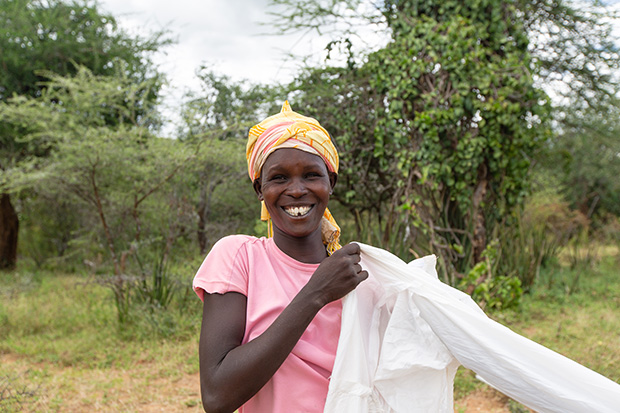At an Ecumenical Advocacy Days workshop last week in observance of the 2021 Earth Day theme “Earth Restored,” two speakers passionately called for increased investments in women led programs as part of the global strategy to address climate change.

Leah Kirakwang is one of the first female bee keepers in the part of Kenya where she lives. Photo: Shanley Studio
Mary Obiero, the director of the Relief, Development and Protection team with CWS Africa, described how women farmers were equipped to become managers of technologies which communities now need to build their climate resilience. They were first trained to manage wells constructed by CWS in their drought-ridden communities. Then they received information and classes in beekeeping – a practice well established in the area, but traditionally the province of men. With additional business orientation, the women converted new activities into additional income which, over time, permitted them to become less dependent on wood for charcoal and pastoralism–on which their farming families have long relied, but which now degrade their increasingly fragile, climate disrupted environment. After a decade, what had started as a water management program evolved into an integrated rural development program enabling deep, lasting changes at domestic and community level, and for the women and girls themselves.
Then, speaking from the Eastern European nation of Georgia, Rostom Gamisonia, a CWS funded agro–economist with decades of experience in designing and managing transformative rural development programs described a similar experience. The NGO Rural Development Agency, which he runs, develops manuals for the use of sustainable climate solutions which are now increasingly important, especially in energy poor communities which not yet connected to national grids. These include clean water technology, sustainable sanitation through the recycling of biomass; the use of non-timber forest products, solar heaters and biomass energy through which communities have been able to independently meet their energy needs through sustainable sources.

A woman in rural Georgia holds up the produce of her agricultural cooperative’s solar dryer program.
Rostom explained that training and education of women is not just central to his center’s approach, it is also a highly effective strategy for rural development.
“Women are open,” he said. “They are willing to start small and try new technologies.”
A growing body of evidence-based literature supports their view, as well as multiple international conventions. For example, the Sendai Framework for Disaster Risk Reduction, and the General Recommendation No 37 of the Convention for the Elimination of Discrimination Against Women – CEDAW – both call for women’s full participation across all areas of disaster risk reduction polices, plans and programs, and for the promotion of gender equality to reinforce the resilience of individuals and community globally, in the context of climate change and disasters.” Likewise, donors – the Green Climate Fund and the Adaptation Fund are examples – have now appointed experts on gender equality and established policies to orient their funding choices from, project design through to monitoring and evaluation. More funding is now flowing to promote women’s involvement across climate change adaptation and mitigation projects, although not yet enough.
There is also growing attention to the links between climate change on migration, including evidence of how women and girls are impacted. A United Nations review of internal migration in Southeast Asia found that women migrating within their home countries are more vulnerable to abuse and exploitation, particularly in domestic work settings. An IDMC study in Ethiopia documents how drought exposes women to gender-based violence in camps for internally displaced persons. As climate change adds to existing migration and displacement, more women and girls may move away from climate hazards only to face new threats. And in places where men are more likely to migrate because of climate impacts on agriculture and rural livelihoods, women are left to shoulder even more responsibilities to maintain households while coping with water scarcity, land degradation, and other climate change impacts.
But Rostom and Mary are right that it is not just money that can turn women’s participation into sustainable, locally rooted climate solutions that benefit the whole community, men and boys included – although money clearly helps. The essential pre-requisites are leadership, tenacity and the personal conviction that women are capable, investment worthy actors who have meaningful roles to play beyond their homes in helping us prepare for a climate-adapted world.
Watch the full panel discussion here: EAD Workshop: Involve Women and Girls to Fix the Climate Crisis! – YouTube
